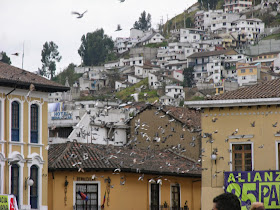Quito, formally San Francisco
de Quito, is the capital city of Ecuador, and at an
elevation of 9,350 feet (2,800 meters above sea level), it is the highest
official capital city in the world.
It is located in north-central Ecuador in the Guayllabamba river basin, on the
eastern slopes of Pichincha, an active stratovolcano in the Andes Mountains.
With a population of 2,671,191 according to
the last census (2014), Quito is the second most populous city in Ecuador,
after Guayaquil.
It is also the capital of the Pichincha
province and the seat of the Metropolitan District of Quito.
The canton recorded a population of 2,239,191
residents in the 2010 national census.
In 2008, the city was designated as the
headquarters of the Union of South American Nations.
184 years ago, Quito was declared capital of Ecuador
Today marks 184 years from the Declaration of Quito as the capital of
Ecuador.
In the government of President Juan José Flores in 1830, the same year
in October Quito was declared the first city in the country.
Quito’s history goes before Spanish Invasion
The Spanish founded Benalcázar Sebastián de Quito in the ruins of an
Indigenous city, December 6, 1534.
And many still remember the old city of Quitu, home of Andean Kichwas.
According to ancient legends, Quito was sacred city was linked to a
fascinating cosmology and mythology, and ancient legends hold that was founded
by quitumbes who escaped the deluge by taking refuge in the heights of
Pichincha.
Archaeological research has shown that at least since 900 a. C., and in
the region there were several settlements developed their activities in the
surrounding areas to the site where the city of Quito stands.
It was the Incas who discovered a piece of land that had the quality to
serve for the foundation of a new city and made it their administrative
headquarter in Ecuador.
It is possible that the name of Quito was the nickname of the local
lord, as was common practice in the Andean peoples called by the names of the
chiefs of the same.
Originally established by Tupac-Yupanqui, during the consolidation of
the Inca conquest, Huayna Capac made it one of the
most important cities of northern Tahuantisuyo (Incan reign).
Later Atahualpa wanted to make her for a second Cuzco; unfortunately
their aspirations were dashed when the Spanish conquerors destroyed the empire
and murdered him, in the July 26, 1533.
Events in the more current Spanish history of South America
The establishment of the first School of Art to Quito became the first
and main training center for artists of Hispanic America.
Many years before they were founded in other similar cities such as
Mexico, Buenos Aires, Santiago and Lima.
Quito Art School's fame became remarkable , between 1779 and 1787,
ie in the course of just eight years, the port of Guayaquil set sail to 264 pictures and statues of Quito artists to Europe.
Several religious congregations not only raised
the most beautiful temples but also-established schools and later the first
universities in Quito.
The San Fulgencio, by the Augustinian friars on August 20, 1586; St.
Gregory the Great, founded by the Jesuits, the September 15, 1622; and Santo
Tomas, founded by the Dominicans in 1786.
In no time Quito had become one of the major cities of the New
World.
King Philip II of Spain
issued the Royal Decree of 29 August 1563, by which the Royal Audience of Quito
was created.
Two years later, Don Hernando de Santillan, first President of the
Audiencia, founded the San Juan de Dios Hospital, which is one of the oldest in
America.
With the Revolution of August 10, 1809 Quito wrote one of the most
glorious pages of its history, to take shape in her as one of the first
Hispanic American insurgencies.
The Quito revolt was the most significant because it resonated in all
Spanish colonies and realistic forced authorities to take drastic measures that
culminated in the murder of the main protagonists of the insurgent movement.
Therefore Quito is called "Light of America".
Twelve years later, when the revolution of October 9, 1820 had already
borne fruit, was fought the Battle of Pichincha on May 24, 1822 that ended the
struggle for Ecuador's independence.
Along with New Granada and Venezuela, Quito joined the Gran Colombia
between 1822-1830.
Finally a civil war resulted in the separation of these territories.
The September 24, 1830, Quito was named capital of the newly born
Republic of Ecuador.
The First Constituent Congress of Ecuador was held in the city of
Riobamba, under President José Fernández Salvador.
This meeting later gave birth to the Republic, by decree issued on
September 24 that declared Quito, forever, as capital of Ecuador.
Historic Quito and the equator
Quito is considered one of the most beautiful
capitals of South America.
The historic center of Quito has also one of
the largest, least-altered and best-preserved historic centers in the
Americas.
Quito, along with Kraków, were the first World Cultural Heritage Sites declared by UNESCO in
1978.
 |
| At the Mitad del Mundo (or Equator) monumental. |
The central square of Quito is located about
25 kilometres (16 mi) south of the equator; the city itself extends to within about 1 kilometre (0.62 mi) of
zero latitude.
A monument and museum marking the general
location of the equator is known locally as la mitad del mundo (the
middle of the world), to avoid confusion, as the word ecuador is Spanish for equator.


















.JPG)
.JPG)





















